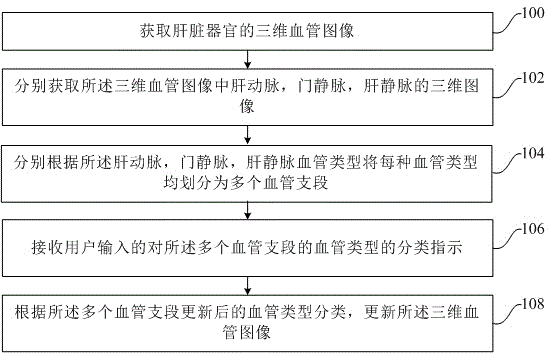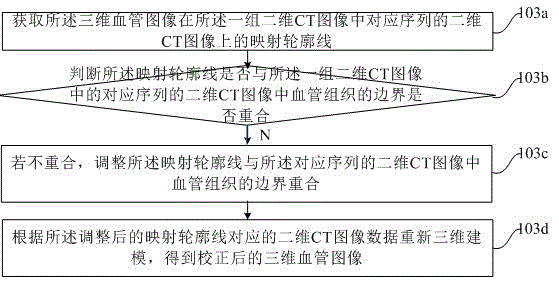Method for sorting hepatic vessels
A technology of liver blood vessels and blood vessels, which is applied in the field of classification of liver blood vessels, can solve the problems of non-vascular tissue mixing, spending more energy, and losing details of blood vessels, so as to improve accuracy, improve the actual medical reference application value, and facilitate preoperative Estimated effect
- Summary
- Abstract
- Description
- Claims
- Application Information
AI Technical Summary
Problems solved by technology
Method used
Image
Examples
Embodiment 1
[0023] An embodiment of the present invention provides a method for classifying liver blood vessels, referring to figure 1 , the method includes the following steps:
[0024] Step 100, acquiring a three-dimensional blood vessel image of the liver organ.
[0025] Wherein, the three-dimensional blood vessel image is obtained by modeling according to a group of two-dimensional CT images in the same period. For example, as described in the background art, an arterial vessel model can be created by using an image in the arterial phase, a portal vein model can be created by using an image in the portal venous phase, and a hepatic vein model can be created by using an image in the equilibrium phase.
[0026] Specifically, for the three-dimensional blood vessel image of the liver organ acquired in step 100, it specifically includes as follows figure 2 as shown,
[0027] 100a. Perform blood vessel segmentation on each two-dimensional blood vessel image in a group of two-dimensional...
Embodiment 2
[0053] Embodiment 2 of the present invention is an improvement on the method for classifying liver blood vessels on the basis of Embodiment 1.
[0054] Specifically, before step 104, dividing each blood vessel type into a plurality of blood vessel branches according to the hepatic artery, portal vein, and hepatic vein respectively, step 103, performing two-dimensional image processing on the three-dimensional blood vessel image Map correction.
[0055] Since in step 100a of the first embodiment, when performing vessel segmentation on each two-dimensional vessel image according to the region growing algorithm, sometimes similar pixels that do not belong to the vessel region are also classified into the vessel region, therefore, the three-dimensional vessel image is divided into each Map the two-dimensional blood vessel image, adjust the inaccurate position, so that the reconstructed three-dimensional blood vessel image is more accurate, so as to conform to the actual vascular s...
Embodiment 3
[0080] The embodiment of the present invention is an improvement on the basis of the first embodiment or the combination of the first embodiment and the second embodiment.
[0081] Specifically, before step 104 of the first embodiment, dividing each blood vessel type into a plurality of blood vessel branches according to the hepatic artery, portal vein, and hepatic vein respectively, or in step 103 of the second embodiment, dividing the three-dimensional After the two-dimensional image mapping correction is performed on the blood vessel image, another step 105 of correcting the three-dimensional blood vessel image is included, removing non-vascular tissue in the three-dimensional blood vessel image.
[0082] Since the embodiment of the present invention is mainly aimed at the three-dimensional image of the blood vessel, the non-vascular tissue in the three-dimensional blood vessel image may be removed first, so as to obtain a more accurate three-dimensional blood vessel image. ...
PUM
 Login to View More
Login to View More Abstract
Description
Claims
Application Information
 Login to View More
Login to View More - R&D
- Intellectual Property
- Life Sciences
- Materials
- Tech Scout
- Unparalleled Data Quality
- Higher Quality Content
- 60% Fewer Hallucinations
Browse by: Latest US Patents, China's latest patents, Technical Efficacy Thesaurus, Application Domain, Technology Topic, Popular Technical Reports.
© 2025 PatSnap. All rights reserved.Legal|Privacy policy|Modern Slavery Act Transparency Statement|Sitemap|About US| Contact US: help@patsnap.com



